
Oscar-Claude Monet was a French painter and founder of impressionist painting who is seen as a key precursor to modernism, especially in his attempts to paint nature as he perceived it. During his long career, he was the most consistent and prolific practitioner of impressionism's philosophy of expressing one's perceptions of nature, especially as applied to plein air (outdoor) landscape painting. The term "Impressionism" is derived from the title of his painting Impression, soleil levant, exhibited in 1874 initiated by Monet and his associates as an alternative to the Salon.

Pierre-Auguste Renoir was a French artist who was a leading painter in the development of the Impressionist style. As a celebrator of beauty and especially feminine sensuality, it has been said that "Renoir is the final representative of a tradition which runs directly from Rubens to Watteau."
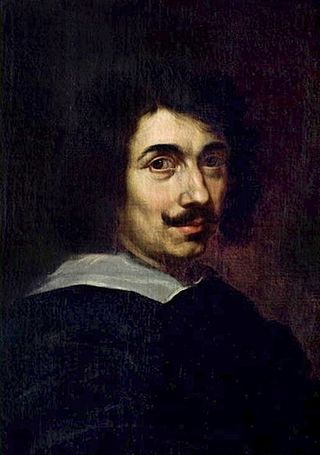
Claude Lorrain was a French painter, draughtsman and etcher of the Baroque era. He spent most of his life in Italy, and is one of the earliest important artists, apart from his contemporaries in Dutch Golden Age painting, to concentrate on landscape painting. His landscapes are usually turned into the more prestigious genre of history paintings by the addition of a few small figures, typically representing a scene from the Bible or classical mythology.

Le Déjeuner sur l'herbe – originally titled Le Bain – is a large oil on canvas painting by Édouard Manet created in 1862 and 1863.

Claude-Joseph Vernet was a French painter. His son, Antoine Charles Horace Vernet, was also a painter.

Adam Elsheimer was a German artist working in Rome, who died at only thirty-two, but was very influential in the early 17th century in the field of Baroque paintings. His relatively few paintings were small-scale, nearly all painted on copper plates, of the type often known as cabinet paintings. They include a variety of light effects, and an innovative treatment of landscape. He was an influence on many other artists, including Rembrandt and Peter Paul Rubens.
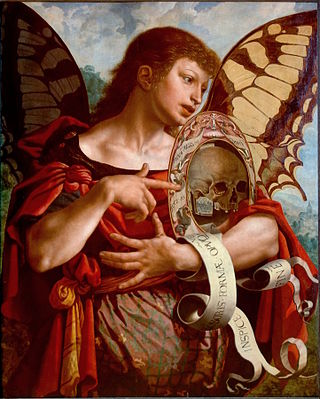
Jan Sanders van Hemessen was a leading Flemish Renaissance painter, belonging to the group of Italianizing Flemish painters called the Romanists, who were influenced by Italian Renaissance painting. Van Hemessen had visited Italy during the 1520s, and also Fontainebleau near Paris in the mid 1530s, where he was able to view the work of the colony of Italian artists known as the First School of Fontainebleau, who were working on the decorations for the Palace of Fontainebleau. Van Hemessen's works show his ability to interpret the Italian models into a new Flemish visual vocabulary.
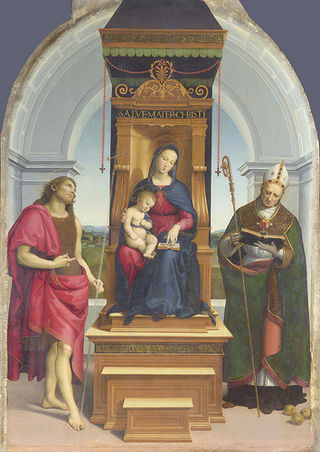
The Ansidei Madonna is a 1505–1507 painting by the Italian High Renaissance artist Raphael, painted during his Florentine period. It shows the Blessed Virgin Mary sitting on a wooden throne, with the child Christ on her lap. On her right John the Baptist stands, on her left Saint Nicholas is reading.

Neri di Bicci (1419–1491) was an Italian painter active in his native Florence. A prolific painter of mainly religious themes, he studied under his father, Bicci di Lorenzo, who had in turn studied under his father, Lorenzo di Bicci. The three thus formed a lineage of great painters that began with Neri's grandfather.
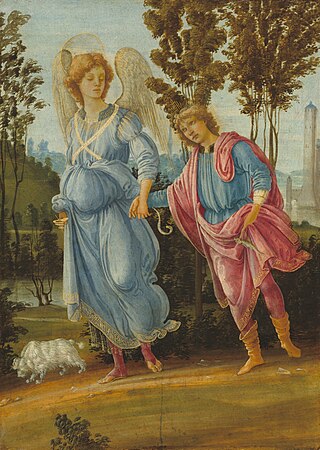
Tobias and the Angel is an oil and tempera painting on poplar panel by the Florentine Renaissance painter Filippino Lippi, dating from c. 1475–1480, of Tobias and the Angel, a popular subject at the time. It is now in the National Gallery of Art in Washington, DC.
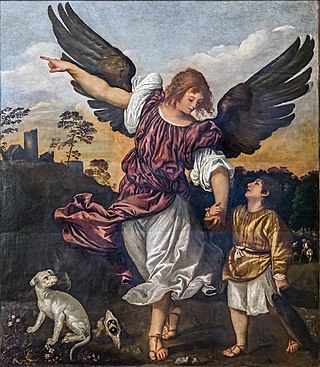
Tobias and the Angel is the traditional title of depictions in art of a scene from the Book of Tobit in which Tobias, son of Tobit, travels with the Archangel Raphael without realising he is an angel (5.5–6) and is then instructed by Raphael what to do with a giant fish he catches (6.2–9). The Book of Tobit is accepted by Catholic and Orthodox Christians as part of the biblical canon, but not by Judaism or most Protestants, the latter including it in the Apocrypha.
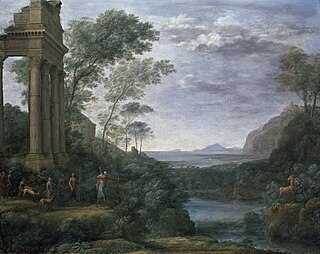
Landscape with Ascanius Shooting the Stag of Sylvia is a painting of 1682 in oil on canvas by Claude Lorrain, a painter from the Duchy of Lorraine who spent his career in Rome. It was painted in Rome for Prince Lorenzo Onofrio Colonna (1637–1689), Claude's most important patron in his last years, and is now in the Ashmolean Museum, Oxford. It is signed, dated with the year, and inscribed with the subject, as Claude sometimes did with his less common subjects.
Tobias and the Angel is a subject art taken from the Book of Tobit. It may refer to a number of works of art and music, including:

The world landscape, a translation of the German Weltlandschaft, is a type of composition in Western painting showing an imaginary panoramic landscape seen from an elevated viewpoint that includes mountains and lowlands, water, and buildings. The subject of each painting is usually a Biblical or historical narrative, but the figures comprising this narrative element are dwarfed by their surroundings.
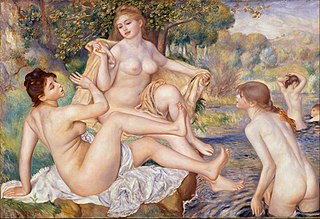
Les Grandes Baigneuses, or The Large Bathers, is a painting by Pierre-Auguste Renoir made between 1884 and 1887. The painting is in the Philadelphia Museum of Art, in Philadelphia.

Tobias and Sarah in Prayer with the Angel Raphael and the Demon is an oil-on-canvas painting by the Dutch Golden Age painter Jan Steen. It is now in the collection of the Bredius Museum, The Hague.

Landscape with Saint Paula of Rome Embarking at Ostia or The Embarkation of Saint Paula is an oil-on-canvas painting by Claude Lorrain. It was painted in 1639–1640 as one of a series of works commissioned by Philip IV of Spain for a gallery of landscapes at the Palacio del Buen Retiro – he also commissioned works from Nicolas Poussin, Herman van Swanevelt, Jan Both, Gaspard Dughet and Jean Lemaire. It is now in the Museo del Prado in Madrid.

Tobias' Journey is an oil-on-panel painting by Flemish artist Joos de Momper. The painting showcases Momper's large scale, imaginary landscape painting and his interpretation of perspective in distant views while at the same time treating a biblical subject. The painting depicts the story of Tobit, a righteous Israelite of the tribe of Naphtali, living in Nineveh, who is sent to recover is father's money to Media, escorted by the Archangel Raphael. The painting is currently housed at the Rockox House in Antwerp.

Tobit and Anna with the Kid, also titled Tobit Accusing Anna of Stealing the Kid, and Tobit Praying for Death, is an early oil painting by the Dutch Golden Age painter Rembrandt, signed and dated 1626. It is now in the Rijksmuseum in Amsterdam.

The Archangel Raphael and Tobias is an oil painting by Titian of Tobias and the Angel, dated to about 1512 to 1514, which is now in the Gallerie dell'Accademia in Venice. Another painting by Titian of the same subject, entitled Tobias and the Angel, dated to about 1540 to 1545, remains in the church of the Madonna dell'Orto in Venice.


















